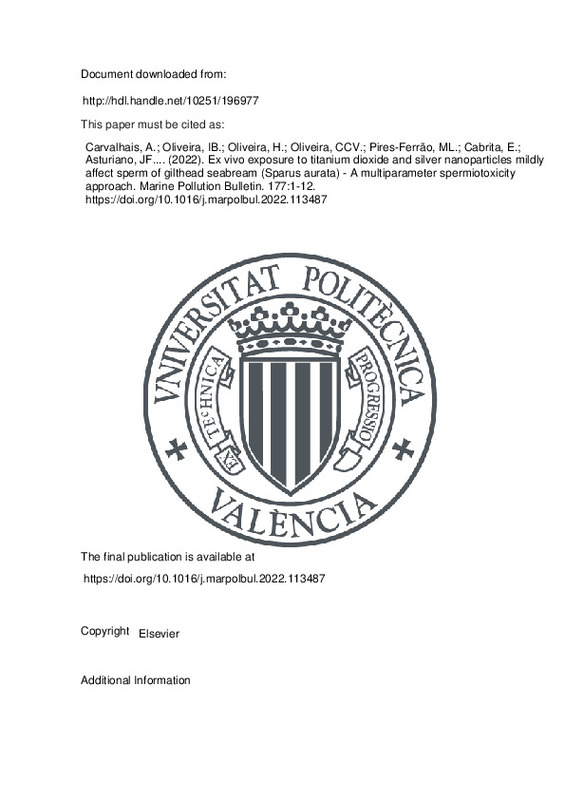Carvalhais, A.; Oliveira, IB.; Oliveira, H.; Oliveira, CCV.; Pires-Ferrão, ML.; Cabrita, E.; Asturiano, JF.... (2022). Ex vivo exposure to titanium dioxide and silver nanoparticles mildly affect sperm of gilthead seabream (Sparus aurata) - A multiparameter spermiotoxicity approach. Marine Pollution Bulletin. 177:1-12. https://doi.org/10.1016/j.marpolbul.2022.113487
Por favor, use este identificador para citar o enlazar este ítem: http://hdl.handle.net/10251/196977
|
Título:
|
Ex vivo exposure to titanium dioxide and silver nanoparticles mildly affect sperm of gilthead seabream (Sparus aurata) - A multiparameter spermiotoxicity approach
|
|
Autor:
|
Carvalhais, A.
Oliveira, I. B.
Oliveira, H.
Oliveira, C. C. V.
 Pires-Ferrão, María Leonor
Cabrita, E.
Pires-Ferrão, María Leonor
Cabrita, E.

 Asturiano, Juan F.
Guilherme, S.
Pacheco, M.
Mieiro, C.L.
Asturiano, Juan F.
Guilherme, S.
Pacheco, M.
Mieiro, C.L.
|
|
Entidad UPV:
|
Universitat Politècnica de València. Escuela Técnica Superior de Ingeniería Agronómica y del Medio Natural - Escola Tècnica Superior d'Enginyeria Agronòmica i del Medi Natural
|
|
Fecha difusión:
|
|
|
Resumen:
|
[EN] Nanoparticles (NP) are potentially repmtoxic, which may compromise the success of populations. However, the reprotoxicity of NP is still scarcely addressed in marine fish. Therefore, we evaluated the impacts of ...[+]
[EN] Nanoparticles (NP) are potentially repmtoxic, which may compromise the success of populations. However, the reprotoxicity of NP is still scarcely addressed in marine fish. Therefore, we evaluated the impacts of environmentally relevant and supra environmental concentrations of titanium dioxide (TiO2: 10 to 10,000 mu g.L-1) and silver NP (Ag: 0.25 to 250 mu g.L-1) on the sperm of gilthead seabream (Sparus aurata). We performed short-term direct exposures (ex vivo) and evaluated sperm motility, head morphometry, mitochondrial function, antioxidant responses and DNA integrity. No alteration in sperm motility (except for supra environmental Ag NP concentration), head morphometry, mitochondrial function, and DNA integrity occurred. However, depletion of all antioxidants occurred after exposure to TiO2 NP, whereas SOD decreased after exposure to Ag NP (lowest and intermediate concentration). Considering our results, the decrease in antioxidants did not indicate vulnerability towards oxidative stress. TiO2 NP and Ag NP induced low spermiotoxicity, without proven relevant ecological impacts.
[-]
|
|
Palabras clave:
|
Reprotoxicity
,
Gametes
,
Marine fish
,
Short-term exposure
,
Sub-lethal effects
,
Quiescent sperm
|
|
Derechos de uso:
|
Reconocimiento - No comercial - Sin obra derivada (by-nc-nd)
|
|
Fuente:
|
Marine Pollution Bulletin. (issn:
0025-326X
)
|
|
DOI:
|
10.1016/j.marpolbul.2022.113487
|
|
Editorial:
|
Elsevier
|
|
Versión del editor:
|
https://doi.org/10.1016/j.marpolbul.2022.113487
|
|
Código del Proyecto:
|
info:eu-repo/grantAgreement/FCT/6817 - DCRRNI ID/LA%2FP%2F0094%2F2020/PT
...[+]
info:eu-repo/grantAgreement/FCT/6817 - DCRRNI ID/LA%2FP%2F0094%2F2020/PT
info:eu-repo/grantAgreement/FCT//UIDB%2F04326%2F2022//CCMAR Strategic Project/
info:eu-repo/grantAgreement/FCT/6817 - DCRRNI ID/UIDB%2F50017%2F2020/PT
info:eu-repo/grantAgreement/FCT//DL57%2F2016/
info:eu-repo/grantAgreement/FCT/9471 - RIDTI/PTDC%2FCTA-AMB%2F30908%2F2017/PT
info:eu-repo/grantAgreement/FCT//DL57%2F2016%2FCP1361%2FCT0007/
info:eu-repo/grantAgreement/FCT/CEEC IND 2018/CEECIND%2F01368%2F2018%2FCP1574%2FCT0005/PT
info:eu-repo/grantAgreement/FCT//CCMAR%2FBI%2F0007%2F2019/
[-]
|
|
Agradecimientos:
|
Funding: This work was supported by the Portuguese Foundation for Science and Technology (FCT, I.P.) [A. Carvalhais -SFRH/2020/05105/BD, C. Mieiro -DL57/2016, S. Guilherme -DL57/2016, C.C.V. Oliveira DL57/2016/CP1361/CT0007, ...[+]
Funding: This work was supported by the Portuguese Foundation for Science and Technology (FCT, I.P.) [A. Carvalhais -SFRH/2020/05105/BD, C. Mieiro -DL57/2016, S. Guilherme -DL57/2016, C.C.V. Oliveira DL57/2016/CP1361/CT0007, I.B. Oliveira -CEECIND/01368/2018, L. Ferrao -CCMAR/BI/0007/2019, CESAM Strategic Project -UIDP/50017/2020+UIDB/50017/2020+LA/P/0094/2020), CCMAR Strategic Project -UIDB/04326/2022]; and the Operational Program Competiveness and Internationalization, Regional Operational Program of Lisboa and Regional Operational Program of Algarve, in its FEDER/FNR component, and the Foundation for Science and Technology, in its State Budget component (OE) [project NanoReproTox -PTDC/CTA-AMB/30908/2017].
[-]
|
|
Tipo:
|
Artículo
|







![[Cerrado]](/themes/UPV/images/candado.png)


